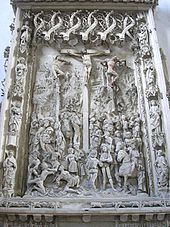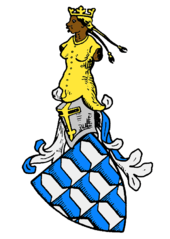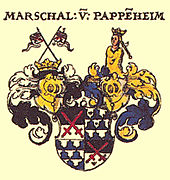Pappenheim (noble family)
Pappenheim is the name of an old Franconian - Swabian noble family of the high nobility , who had their headquarters in the town of the same name Pappenheim and at Pappenheim Castle on the Altmühl . From around 1100 to 1806, the family held the office of Reichsherbmarschall (Vicemarescallus) in deputy of the Elector of Saxony as Archmarschall of the Holy Roman Empire .
The gender is not to be confused with the Westphalian raven von Pappenheim .
history
origin
The progenitor is the Ministeriale Heinrich Haupt ( Henricus Caput ), a follower of Emperor Heinrich V , who first appeared in a document in 1111. Possibly he was a son or brother of Konrad, Marshal of King Henry IV, mentioned in the crusade of 1101 .
A Henricus de Pappenheim is mentioned in documents from 1138 to 1147, and in 1141 as a marshal. Haupt's successor Heinrich II took under the first Staufer Konrad III. as marshal in the Second Crusade (1147/49). It could also have been Heinrich who, with Emperor Friedrich I Barbarossa, made the second Italian campaign (1158/62). He also took part in the Fourth Italian Train (1166/68) and survived the epidemic. He was in office from 1168 to 1173. Marshal Heinrich III. (also called Head II, because he is mentioned by the nickname Testa , * around 1137) was Barbarossa's advisor in 1174 and was appointed under his son, Emperor Heinrich VI. Marshal and Legate. Together with the emperor, he failed in the siege of Naples (1191) and probably died in Montecassino in 1191 . Heinrich von Kalden (* before 1175, † after 1214), Imperial Court Marshal of Emperor Heinrich VI from 1191, was probably a son of Heinrich III. Testa.
The family name thus initially vary between Caput , Testa (both lat. For major ) or cum Caputae , which is (with the head) on the crest symbol of the winning with a headband Imperatore head refers to the family resulted in the seal and that the Mohr converted , their crest and later also the city arms of Pappenheim . The early family members were always referred to as marshal , but they were also called Kalendin or Kalden . The family seat, Pappenheim Castle , was called "Kalteneck Castle" in the Middle Ages.

The Reichsmarschallamt , one of the hereditary offices of the Holy Roman Empire, was probably owned by the family from around 1100, documented with the name Pappenheim since 1141. Another Heinrich von Pappenheim called himself Marshal by the grace of God of the imperial court and the Duchy of Swabia in 1263 . Since 1420 they have held the title of Reichsherbmarschall . Their function emerged in the election and coronation of emperors as well as the Reichstag . They were supported by the Reich Quartermaster. In addition, they were given the office of master forestry and hunter in the north of the district. After the Counts Pappenheim had split up into several lines, the administration of the Lower Marshal's Office always remained with the senior resident in Pappenheim since 1473 . This line was allowed to call itself (since 1574) "zu Pappenheim", all others only "von Pappenheim".
There is an extensive family burial place in the Pappenheim Monastery .
Development of the different lines
After the line of Marshal Heinrich von Kalden and that of the older Biberbachers with Ulrich von Pappenheim-Rechberg had died out in 1231 in the 13th century, the older or Pappenheimer line and von Marschall emerged in the same century, coming from Marshal Heinrich VII Hiltprand founded, the younger line, named after the second family seat Biberbach , with further branches.
In 1444, the family split under the heirs of Marshal Haupt II. Into the lines Alesheim , Bad Grönenbach (extinct 1612), Rothenstein (extinct 1639), Treuchtlingen (extinct 1647) and Graefenthal in Thuringia (extinct 1599).
The cohesion despite religious differences was preserved through family contracts. Dominion and Burg Pappenheim were ruled together and administered by the respective family senior, comparable to other imperial counts such as the Bavarian Ortenburgers . Thus the paperboard local rule was divided into family, line and individual property. Involved in the question of denomination between the Protestant Saxon elector and the Catholic head of the empire, the Pappenheimers could only act cautiously. While Gräfenthal joined the Lutherans in 1530, others occupied Pappenheim's bishops and canons. Only after the Peace of Augsburg in 1555 did the rulers of Rothenstein (1558), Treuchtlingen (1559) and Pappenheim (1562) introduce the Reformation. Family cohesion was regulated in internal contracts of 1534 and 1580. This included, above all, provisions on the seniorate and joint rule as well as legal aid.
Wolfgang zu Pappenheim (1539–1558)
Heinrich zu Pappenheim (1562–1590)
Maximilian zu Pappenheim (1635–1639)
Pappenheim

The Staufer castle Pappenheim in Pappenheim an der Altmühl was completed in 1175, as the consecration date of the castle chapel reveals. This complex was probably built as an imperial castle, which was given as a fief , later as an allod , to the imperial ministerial family of the Calatine , who now called themselves Marshals von Pappenheim. As a residential town, Pappenheim became the regional center of rule; the Reichsherbmarschalls had privileges such as neck court and Judenregal . During the Thirty Years' War the castle had to be handed over to the Swedes after a short siege in 1634. In the War of the Spanish Succession , it was captured and damaged by French troops in 1705. It then fell apart and was transformed into a romantic ruin at the beginning of the 19th century, which corresponded to the taste of the time. As early as 1593, Wolf Christoph zu Pappenheim had moved from the castle to the old Pappenheim Castle , which was created by expanding an older building in the city. It remained the residence of Marshals von Pappenheim until the New Palace was built around 1820, which the architect Leo von Klenze designed in the classicistic style. This is still the residence of descendants in the female line of the Counts of Pappenheim.
After the acquisition of the direct imperial rule of Pappenheim at the beginning of the 12th century, members of the family received further possessions and goods.
Biberbach
The places Biberbach and Markt are already mentioned in the Pappenheimer Urbar in 1214. The marshals von Rechberg, who were related to the Pappenheimers (Hildebrand, son Ulrich I. von Rechberg married Anna von Pappenheim) also owned property in Biberbach and the surrounding area, which later fell to the Pappenheimers through succession. In 1279 the brothers Heinrich and Hiltbrand von Pappenheim divided the property in such a way that the younger Hiltbrand received the entire property south of the Danube, including Biberbach. After 1300, the descendants only rarely called themselves "von Pappenheim", but mostly "Marshals von Biberbach". One of Hiltbrand's descendants sold the Biberbach rulership with the towns of Biberbach, Markt, Eisenbrechtshofen , Prettelshofen , Langenreichen and Feigenhofen on June 16, 1514 for 32,000 guilders to Jakob Fugger .
Burg Markt near Markt
Treuchtlingen
Georg zu Pappenheim bought the place Treuchtlingen back from the Seckendorffers in 1447/53 . Treuchtlingen then remained a fiefdom of the Margraves of Ansbach from the House of Hohenzollern , who thus had a decisive influence on the denomination. At times it was pledged to the Teutonic Order in Ellingen . The original seat of power was Treuchtlingen Castle , but the Treuchtlingen City Palace , which Veit zu Pappenheim had rebuilt in 1575, also existed. His famous son Gottfried Heinrich was born there on May 29, 1594 . Reichsherbmarschall Veit zu Pappenheim (1535–1600) had been Protestant since 1555 (his father had already led Martin Luther to Worms for interrogation in 1521 ) and therefore lost the Bavarian Hofmark Schwindegg , which he had to sell in 1591 to the knight Sebastian von Haunsperg . After the death of Field Marshal Gottfried Heinrich Graf zu Pappenheim , in the battle of Lützen in 1632 and the death of his son in a duel with Martin Maximilian von der Goltz , the Treuchtling line was extinguished in 1647, and Treuchtlingen fell to the Margraves of Ansbach.
Treuchtlingen Castle around 1420
Rothenstein
After Ludwig von Rothenstein's death in 1482, Rothenstein Castle and the Grönenbach High Castle came into the possession of the von Pappenheim family. Philipp von Pappenheim , who from 1559 had the first Calvinist sermons held in Grönenbach near the castle , also lived at Rothenstein Castle . During the Peasants' War in 1525, Rothenstein Castle was taken by rebellious farmers. Marshal Wolfgang von Pappenheim and the widow of Marshal Alexander von Pappenheim had to flee from Rothenstein Castle to Kempten during the occupation . In 1612/13 the Grönenbach High Castle was inherited by the Fuggers of Kirchberg-Weißenhorn. During the Thirty Years' War, Rothenstein Castle was also looted in 1632. In 1646 the castle was the headquarters of the Swedish Field Marshal Carl Gustav Wrangel . In 1692 Count Philipp Gustav zu Pappenheim sold the castle for 65,000 guilders to the prince monastery of Kempten .
Landgraviate of Stühlingen
The Landgraviate of Stühlingen came to Maximilian von Pappenheim in 1582 after the death of Count Heinrich VI., The last of the Lords of Lupfen . As early as 1583, Imperial Hereditary Marshal Conrad von Pappenheim acquired the rule and rights to manfair, the county of Stühlingen and the old castle, which had been dilapidated since the Swiss Wars, for 80,000 florins. The actual mortgage was only given after all disputes had been settled in 1603. Conrad died in August 1603. His son Maximilian was his successor. From 1620 to 1623 he had the old castle demolished and rebuilt today's Hohenlupfen Castle in a simple form . His only son, Hereditary Marshal Heinrich Ludwig, fell as a Swedish colonel during the siege of Hohenstoffeln in June 1633. When his daughter Maximiliane married Count Friedrich Rudolf von Fürstenberg in 1631, the Landgraviate fell to the Fürstenberg family .
Graefenthal (Thuringia)
Duke Wilhelm III. von Sachsen sold Wespenstein Castle in Graefenthal with all associated places and rights in 1438 to the Pappenheimers without giving up fiefdom . The founder of the Graefenthaler line was Conrad von Pappenheim . Sebastian von Pappenheim , married to Ursula von Wallenrod , extended the residence generously from 1517 to 1541. In the now stately castle he received Martin Luther and the Saxon Elector Johann the Steadfast in 1530 and in 1547 Emperor Charles V and Duke Alba . Joachim von Pappenheim died there in 1575, his grave slab is preserved in the town church of St. Marien . On December 11, 1599, the last member of the Graefenthal lineage, Reichsmarschall Christoph Ulrich von Pappenheim, died there . From 1612 Philipp von Pappenheim from the Rothenstein line together with his nephew Maximilian ruled Gräfenthal. With Philip's death in 1619, it fell completely to Maximilian von Pappenheim . He sold the lordship to the House of Wettin in 1621 for 130,000 guilders .
Representatives and ranks

Because of the ownership or partial ownership of the Stühlingen , Hohenreichen and Wertingen estates , the lords of Pappenheim were members of the imperial knighthood in the knightly cantons of Altmühl and Steigerwald of the Franconian knight circle in the 17th century . Because of the ownership and partial ownership of Ramsberg and Wildenstein , they were also registered in the knight canton of Kocher of the Swabian knight circle from the middle of the 16th century until 1805 .
In 1628 they were given the status of imperial count in the Swabian count bank . The immediately imperial county Pappenheim an der Altmühl fell in 1806 through mediation to the Kingdom of Bavaria. In 1815, as compensation for the loss of the Reichserbmarschall's office, the family was entitled to the granting of a rulership area in the Saar department (an der Nahe), which the family waived shortly afterwards in exchange for monetary compensation from the Prussian state .
The most important Pappenheimer Gottfried Heinrich zu Pappenheim comes from the line of Pappenheimers in Treuchtlingen . The well-known, originally positive expression goes back to him: " This is how I recognize my Pappenheimer ". He and his cousin Wolfgang Philipp received from Emperor Ferdinand II on May 19, 1628 the dignity of Imperial Count in Prague , which was granted by Emperor Charles VI. in 1740 and Emperor Karl VII in 1742 was confirmed to Marshal Friedrich Ferdinand von Pappenheim.
In 1524 he was accepted into the Tyrolean aristocratic registers . In the Kingdom of Bavaria , a rescript in 1825 recognized that the Counts of Pappenheim belonged to the high nobility . The predicate " Grace " was in 1831 by special ceremony at the primogeniture for Carl Graf and Mr. Pappenheim acknowledged Bavarian lieutenant general and adjutant general of the king. An Austrian recognition took place on February 22, 1847 in Vienna and a Bavarian extension to all members of the family on March 7, 1911.
Over time, most of the Pappenheimer lines died out. The line of Gottfried Heinrich zu Pappenheim died out in 1647 with his son from his first marriage, Wolf Adam. The Alesheim line still exists today.
Karl Theodor Graf zu Pappenheim , the son-in-law of the Prussian State Chancellor Karl August von Hardenberg , was involved from December 1, 1821 to September 1823 in solving the problems before the marriage of Elisabeth of Bavaria , the Catholic daughter of the Bavarian King Maximilian I Joseph , with the Protestant Prussian Crown Prince Friedrich Wilhelm .
progeny

The descendants of this family still bear the name Grafen zu Pappenheim and are native to Bavaria, Switzerland and Austria. After the death of the head of the family, Ludwig Graf zu Pappenheim, with whom the main line of the male line was extinguished in 1960, the ownership of the headquarters in Pappenheim was inherited by his daughter Ursula Gräfin zu Pappenheim (1926-2018). Her marriage to Gert Graf von der Recke von Volmerstein (1921–1991) had a daughter Iniga (* 1952), who is married to Albrecht Graf von Egloffstein (* 1946). Egloffstein is now the managing director of the Graeflich Pappenheim'schen Güterverwaltung.
To this day there are still two younger lines: the Catholic II line, which goes back to Count Alexander (1819–1890) and resided in Iszkaszentgyörgy (Hungary) until 1945, and the Catholic II line, which goes back to Count Maximilian (1824–1906) and resided in Gundelsheim until 1968 , Protestant III. Line.
coat of arms
The family coat of arms shows three rows of blue-silver iron hats ( fur or iron hats ), on the helmet the torso of a gold-crowned and gold-clad Mohrin with two gold braids. The helmet covers are blue-silver.
In the course of time, improvements to the coat of arms came to the family. With Siebmacher the coat of arms is quartered , 1 and 4 divided by black and silver, with crossed red swords (coat of arms of the Hereditary Marshal), 2 and 3 the family coat of arms. On the right helmet with black and silver helmet covers, two crossed flags as described in fields 1 and 4, on the left the trunk helmet.
Historical coats of arms
Coat of arms of the Pappenheim family from Scheibler's book of arms
Coat of arms of a Marshal von Pappenheim from Siebmacher's coat of arms book
Coat of arms graphic by Otto Hupp in the Munich calendar of 1904
Local coat of arms with Pappenheim elements
The Eisenhutfeh can still be seen today in numerous Bavarian coats of arms. The Pappenheimer Mohrin from the city arms of Pappenheim took over the family as a helmet ornament .
Coat of arms of the city of Pappenheim
Coat of arms of the Weißenburg-Gunzenhausen district
Coat of arms of the city of Treuchtlingen
Coat of arms of the municipality of Allmannshofen
Coat of arms of the municipality of Winterbach
Coat of arms of the municipality of Mertingen
Coat of arms of the community of Alesheim
Coat of arms of Markt Berolzheim
Coat of arms of the municipality of Lachen (Swabia)
Coat of arms of the city of Graefenthal
Personalities (chronological)

- Haupt II. Von Pappenheim (1380–1438), Reichserbmarschall
- Henry XI. von Pappenheim (1400–1482), founder of the Allgäu and Stühlinger line
- Conrad III. von Pappenheim (* before 1420; † 1482), founder of the Graefenthal line
- Georg I von Pappenheim (1430–1485), founder of the Treuchtling line
- Sigmund von Pappenheim (* before 1440; † 1496), founder of the Alezheimer line
- Heinrich XII. von Pappenheim († 1511), bailiff of Augsburg
- Caspar von Pappenheim († 1511), Canon of Eichstätt, donor of the Pappenheimer altar (around 1495) in Eichstätt Cathedral
- Wilhelm I. von Pappenheim († 1508), imperial councilor
- Alexander I. von Pappenheim (1435–1511), founder of the Pappenheim-Grönenbach line
- Matthäus von Pappenheim (Biberbach line) (1458–1541), canon at Augsburg Cathedral , humanist, chronicler and genealogist
- Sebastian von Pappenheim (* before 1472; † 1536), Saxon councilor and owner of the senior council of the Reichsherbmarschallamt from 1529
- Joachim von Pappenheim (1490–1536), builder of Neu-Kalden Castle near Altusried
- Christoph Marschall von Pappenheim (1492–1539), Prince-Bishop of Eichstätt (1535–1539)
- George III von Pappenheim (* around 1500; † 1563), Bishop of Regensburg (1548–1563)
- Wolfgang von Pappenheim (* before 1509; † 1558), imperial councilor
- Heinrich Burghard I. von Pappenheim (before 1510–1547), governor of the prince monastery of Kempten
- Henry XIII. von Pappenheim (before 1530–1590), Austrian and Bavarian council
- Alexander II von Pappenheim (1530–1612), German Imperial Hereditary Marshal and Imperial Councilor
- Conrad von Pappenheim (1534–1603), Imperial Colonel
- Veit zu Pappenheim (1535–1600), Reichserbmarschall
- Wolfgang II. Von Pappenheim (1535–1585), Imperial Hereditary Marshal
- Christopher III. von Pappenheim (1538–1569), Marshal
- Philipp von Pappenheim (1542–1619), introduced the Calvinist doctrine in Grönenbach
- ∞ Anna von Pappenheim, b. Freiin von Winneburg and Beilstein (1570–1635), wife of Philip
- Christoph Ulrich von Pappenheim (1546–1599), Reichshermarschall and last representative of the Pappenheim-Graefenthal line
- Wolfgang Christoph von Pappenheim (1567–1635), Marshal and owner of the senior council of the Pappenheim family
- Wilhelm IV von Pappenheim (1569–1621), marshal and builder of the Upper Palace in Markt Berolzheim
- Maximilian von Pappenheim (1580–1639), Landgrave of Stühlingen
- Anna Fugger, b. von Pappenheim (1584–1616), heiress of Grönenbach
- Gottfried Heinrich Graf zu Pappenheim (1594–1632), general in the Thirty Years War
- Karl Theodor Graf zu Pappenheim (1771-1853), Bavarian field warrior and last ruling imperial count of the county of Pappenheim
- ∞ Lucie von Hardenberg (1776–1854), wife of Count Karl Theodors and Prince Hermann von Pückler-Muskau
- Albert Graf zu Pappenheim (1777–1860), Bavarian lieutenant general, writer and member of parliament
- Adelheid Princess von Carolath-Beuthen, b. Countess von Pappenheim (1797–1849), author and landscape painter
- Clemens Graf zu Pappenheim (1822–1904), Bavarian councilor
- Ludwig Magnus Graf zu Pappenheim (1862–1905), Bavarian Imperial Councilor
See also
- Tribe list of the Pappenheim
- Raven von Pappenheim
- List of German noble families N - Z
- List of Frankish knight families
- List of Swabian noble families
literature
- Reinhard Heydenreuter : Pappenheim, from. In: New German Biography (NDB). Volume 20, Duncker & Humblot, Berlin 2001, ISBN 3-428-00201-6 , pp. 48-50 ( digitized version ).
- Otto Hupp : Munich calendar 1898. Book a. Art Print AG, Munich / Regensburg 1898.
- Genealogical manual of the nobility , Adelslexikon. Volume X, Volume 119 of the complete series, CA Starke Verlag, Limburg (Lahn) 1999, ISSN 0435-2408
- Gerhard Köbler : Historical lexicon of the German countries. The German territories from the Middle Ages to the present. 7th, completely revised edition. CH Beck, Munich 2007, ISBN 978-3-406-54986-1 .
- Hans Schwackenhofer: The Reichserbmarschalls, counts and gentlemen from and to Pappenheim. On the history of a family of Reich ministers. Verlag Walter E. Keller, Treuchtlingen - Berlin 2002. ISBN 3-934145-12-4 .
- Wolfgang Wüst: Article: A. [Dynasty] Pappenheim. In: Werner Paravicini (eds.), Jan Hirschbiegel / Anna Paulina Orlowska / Jörg Wettlaufer (edit.), Courtyards and residences in the late medieval empire: Counts and Lords, Part 2 (Residency Research 15 / IV, Part 2) Ostfildern 2012, p. 1092-1095.
- Wolfgang Wüst: Article: B. [Grafschaft and Herrschaft] Pappenheim. In: Werner Paravicini (Ed.), Courtyards and Residences in the Late Medieval Empire: Counts and Lords, Volume 2, pp. 1095-1097.
- Wolfgang Wüst: Article: C. [Residence] Pappenheim. In: Werner Paravicini (Ed.), Courts and Residences in the Late Medieval Empire: Counts and Lords, Part 2, pp. 1097-1098.
- Daniel Burger : Pappenheim, Reichsmarschalls von . In: Historical Lexicon of Bavaria. 2016.
- Maik Reichel (Ed.), This is how I recognize my Pappenheimer. Gottfried Heinrich zu Pappenheim. Of the Reich Hereditary Marshal and General, 2014 (Janos Stekovics publisher).
Web links
- Coat of arms of the Pappenheim in the Ortenburg coat of arms book from 1466 and in the anthology of several coat of arms books , southern Germany (Augsburg?) Around 1530
- Historical lexicon of Bavaria - Reichsmarschälle von Pappenheim
- German biography - Von Pappenheim
- Pappenheim - Franconian county and residence
- County of Pappenheim
- Genealogy of the Pappenheim (English)
Individual evidence
- ↑ Haupt Graf zu Pappenheim: The early Pappenheim marshals from the 12th to z. 16th Century. Vol. 1.
- ↑ a b Joseph Sedelmayer; Historical association for the entire promotion of local history of the Allgäu (ed.): History of the market town of Grönenbach. Kempten 1910, p. 249.
- ^ Johann Adolph von Schultes: Sachsen-Coburg-Saalfeldische Landesgeschichte. 1820, p. 130.





























